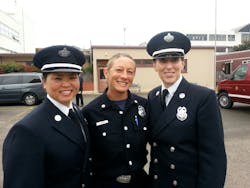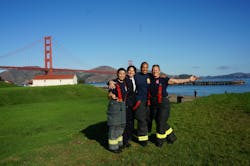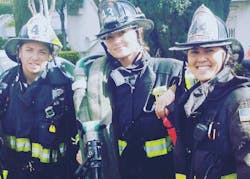A few years ago, a female firefighter who served in a small rural department was diagnosed with breast cancer. After the diagnosis, the firefighter was directed to the department’s secretary (who also functioned as the human resources director and the disability officer) to fill out the necessary initial injury paperwork.
Not sure how to answer all of the disability questions and looking for direction, the firefighter asked the secretary, “Do you think my cancer is job-related?” The secretary replied, “No, honey, firefighting didn’t cause your breast cancer.” The critical box asking whether the injury was work-related was left unchecked. As a result, this firefighter fought many legal battles with her department but never received compensation for her injury.
This case is far from unique and not exclusive to women firefighters but highlights the lack of peer support and isolation that many women firefighters experience when diagnosed with breast cancer. The lack of information and understanding that surrounds breast cancer in a minority population, particularly women in the fire service, is tangible. Could a bit of education and a few resource recommendations help to prevent this outcome from happening to other women firefighters across the nation?
For the past six years, I have been involved in a study that looks at chemical exposures in women firefighters that are work-related. This work has taught me to respect and understand the power of science as it relates to you and me—our firefighter community.Because my colleagues were getting sick from and dying of cancer, I became interested in cancer as an occupational disease and began working with local scientists and breast cancer advocates to determine why this was happening and what could be done. Please be advised, the implications for health and wellness outcomes and cancer concerns of particular relevance to women firefighters (and the information that’s provided) are relevant for other types of cancer in the fire service and can be used to benefit all.
Women make up less than 10 percent of firefighters across the nation. However, as departments continue to diversify, it is important to understand the extent of chemical exposures in the workplace and to explore tangible ways to protect the health of women firefighters.
A higher chance of cancer?
Occupational cancer is a critical issue that the nation’s firefighters face. In fact, it is the leading cause of death in firefighters today. Although we know that some cancers are influenced by a person’s behaviors (such as tobacco use and sun exposure without protection), these “lifestyle factors” aren’t enough to explain cancer in the fire service. Is it possible that the occupation of firefighting could be causing cancer? The International Agency for Research on Cancer (IARC), which ranks different exposures for their cancer risk based on available science, classifies the occupation of firefighting as class 2B carcinogen, or possibly carcinogenic. In addition, firefighting is the only occupation to be reviewed by the IARC for its cancer risk.
Firefighters are exposed to known carcinogens and hundreds of other chemicals on the fireground and in the station, from diesel exhaust and firefighting foams to even PPE. The fire service’s occupational exposures can be described as a chemical soup that contains thousands of chemicals. Some of the chemicals are known or suspected carcinogens, but many others lack toxicity data that make it difficult to assess the health effects of all of the chemicals to which we are exposed.
Cancer doesn’t develop all at once. It happens through a series of changes in body processes that collectively transform normal cells into cancer cells. Many chemicals that can interact with these processes are considered partial carcinogens. They don’t cause cancer by themselves, but exposures to high levels of chemicals or to combinations of these substances might overwhelm the body’s defenses, which can result in cancer.
Starting in 2012, firefighters noticed an alarming uptick in breast cancer diagnosis among the ranks of the San Francisco Fire Department (SFFD). While searching for information on incidences of cancer in women firefighters, and to better understand chemical exposures with relevance to women’s health, I was surprised that I could find no such information. There were many studies about firefighters that documented increased exposures to carcinogenic compounds and elevated rates of certain cancer, but this research focused exclusively on men. I now understand that one of the reasons for this data gap is because of the underrepresentation of women in the profession. The low number of women firefighters makes it difficult for scientists to characterize women’s workplace exposures.
To understand how women firefighters are exposed to potential breast carcinogens and other chemicals, it was clear that we needed to create our own data. At approximately 15 percent of the workforce, the SFFD has the largest number of women firefighters of any urban fire department in the country. This makes it the ideal location to conduct a research study that focuses exclusively on women firefighters.
We undertook a community-based participatory biomonitoring project that was funded by the California Breast Cancer Research Program. This partnership of firefighters, environmental health scientists and advocates became the Women Firefighters Biomonitoring Collaborative (WFBC). It sought to address the gap in information on occupational exposures among women firefighters by examining exposures to environmental chemicals that are linked to breast cancer, including potential carcinogens and chemicals that disrupt the body’s normal hormone function.
The WFBC collected biospecimens and interview data from 80 women firefighters and 80 women office workers from San Francisco. The samples were analyzed for perfluorinated chemicals and flame retardants. Study updates and recent publications can be found by visiting biomonitoringcollaborative.org. For a recently published scientific paper on perfluoroalkyl substances (PFAS) in women firefighting, you also can read the article, “Exposure to Perfluoroalkyl Substances in a Cohort of Women Firefighters and Office Workers in San Francisco,” which was published in the scientific journal Environmental Science & Technology. It will be available for download starting in February 2021.
Warning signs for cancer?
Because cancer prognosis is better when cancer is caught in its early (incipient) stages, it is recommended that you get tested early and often. Currently, there are reliable screenings for breast, cervical, colorectal and lung cancer. You might need to educate your clinician to consider initiating earlier screening or screening at an increased frequency because you are firefighter.
A national nonprofit, 15-40 Connection is devoted to improving cancer survival rates through the power of early detection. It developed a training program that’s particularly for first responders. It teaches firefighters to baseline their good health, to recognize subtle changes to their health that persist for two weeks, which could be symptoms of cancer, and to share those observations with their doctor. No one knows your health like you do, so your awareness, your voice and your actions can help you to recognize cancer symptoms early and to take steps to give yourself a life-saving advantage.
Making a difference
If you’re a healthy firefighter, there are several ways that you can be involved.
Consider participating in clinical research that’s uncovering the relationship between chemical exposures and cancer. Join the National Firefighter Registry (NFR). In 2018, Congress directed the Centers for Disease Control and Prevention to create a database of health and occupational information on firefighters that can be used to analyze and track cancer in the fire service. In addition, this database can help to identify occupational risk factors for cancer at a national level. The information that’s collected by the NFR can help the public safety community, researchers, scientists and medical professionals better protect firefighters’ health and safety. Registration in the NFR is voluntary.
Support the efforts of cancer prevention organizations locally via a donation. If you’re a firefighter who has cancer, consider reaching out to the Firefighter Cancer Support Network (FCSN) (firefightercancersupport.org/). The FCSN aims to support fire/EMS professionals and their families following a cancer diagnosis. The organization offers peer support and gives cancer awareness and prevention training nationwide. The FCSN is a way for women to support each other through this great network.
Learn about and get involved with policy changes that can improve first responders’ health and safety, such as chemicals policy reform. Encourage your local, state and federal representatives to support policies that will better protect workers by reducing exposures that are linked to adverse health outcomes, such as breast cancer. This won’t happen without significant and sustained collaborative pressure from local and national firefighting organizations and advocacy groups that’s supported by boots on the ground. Presumptive laws are regulations that assume that a given disease is linked to work by default. This means that when someone is diagnosed with an illness that’s covered under a presumptive law, he/she automatically is entitled to disability or workers’ compensation, medical expense coverage and medical leave. Many states still lack presumptive cancer laws, and many of the laws that exist are limited. Currently, only 12 states proactively include breast cancer in their presumptive laws.
Science is important, because it can validate exposure experiences, lending evidence to help to build strong presumptive laws in every state. The good news is that firefighters have had success changing laws, particularly with the help of science. A great example of this took place in 2018 in Massachusetts where Boston firefighters/Local 718 were successful with a bill that proposed to include breast and reproductive cancers into the cancer presumption list to protect women firefighters who serve in the state.
Protecting yourself on the job
Efforts to educate firefighters about safe work practices, including proper training, proper use of protective clothing, and proper decontamination steps on the fireground and in the station, have created a groundswell in our profession that is changing the narrative for fire service personnel in regard to cancer. The strong leadership of the IAFF and the work and dedication from many local unions across the nation and Canada have raised awareness of exposure prevention efforts that help local departments to recognize and embrace the need to reduce occupational exposures that are associated with increased cancer risk.
We all swore an oath to protect the lives and property of the residents we serve. We don’t get to choose which fires we fight, and we don’t turn away because a fully involved fire looks potentially dangerous or toxic. Please, after every fire, tend to your own decontamination, then remind your fellow firefighters to do the same and to follow best practices when possible.
Firefighters don’t need science or clinicians or legislators to tell us that this is a dangerous job. We only need to look left and then right when sitting down to a firehouse dinner to notice the missing friends and colleagues who are getting sick and dying of cancer.
About the Author
Heather Buren has been a member of the San Francisco Fire Department since 1997. She cross-trained as a firefighter/paramedic early in her career, promoting to lieutenant in 2010. She is a co-primary investigator of Women Firefighter Biomonitoring Collaborative Study and The Women Workers Biomonitoring Study and is involved in the Tubbs Fire Research Study. Buren is a long-time member, past president and current board member of the United Fire Service Women.
5 Tips to Reduce Exposure at the Station
- Store turnouts in closed lockers and gear bags
- Keep doors closed between the apparatus floor and living areas
- Wipe down the vehicle cab interior every day
- Do not sweep the apparatus floor; vacuum with a certified HEPA shop vac and mop
- Use your station’s vehicle exhaust system
5 Tips to Reduce Exposure on the Fireground
- Use SCBA from the initial attack through the completion of overhaul
- Use wet wipes to clean hands, neck, jaw and face after fire operations
- Do a gross decontamination of PPE and place in a sealed bag in an outside compartment of your vehicle if possible
- Shower immediately upon returning to your station
- Thoroughly clean all PPE, including helmet and SCBA


